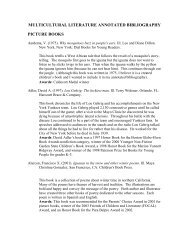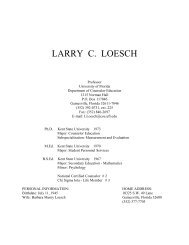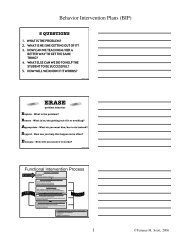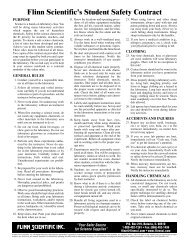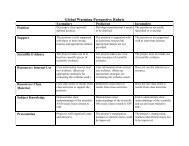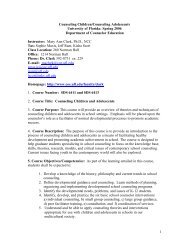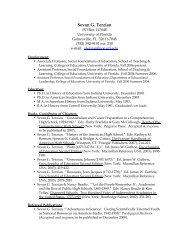The Effects of Distance Education on K-12 Student Outcomes: A ...
The Effects of Distance Education on K-12 Student Outcomes: A ...
The Effects of Distance Education on K-12 Student Outcomes: A ...
You also want an ePaper? Increase the reach of your titles
YUMPU automatically turns print PDFs into web optimized ePapers that Google loves.
pr<str<strong>on</strong>g>of</str<strong>on</strong>g>essi<strong>on</strong>al development becomes more comm<strong>on</strong> and expertise grows, student success is likely<br />
to grow as well.<br />
As sec<strong>on</strong>d factor that is growing in importance in K-<strong>12</strong> distance educati<strong>on</strong> is the emergence <str<strong>on</strong>g>of</str<strong>on</strong>g><br />
virtual charter schools. By 2002, there were about 2000 charter schools nati<strong>on</strong>wide, and the No<br />
Child Left Behind Act allows public schools that “chr<strong>on</strong>ically fail” to make adequate yearly<br />
progress to be restructured as charter schools (Nels<strong>on</strong>, Rosenburg & Van Meter 2004, page 1).<br />
According to state department <str<strong>on</strong>g>of</str<strong>on</strong>g> educati<strong>on</strong> websites, there are now almost 100 virtual charter<br />
schools operating. This synthesis includes data from ten virtual charter schools, all <str<strong>on</strong>g>of</str<strong>on</strong>g> which<br />
performed at levels equivalent to n<strong>on</strong>-virtual public schools in their states. In c<strong>on</strong>trast, the 20004<br />
report <strong>on</strong> charter school achievement <strong>on</strong> the Nati<strong>on</strong>al Assessment <str<strong>on</strong>g>of</str<strong>on</strong>g> <str<strong>on</strong>g>Educati<strong>on</strong></str<strong>on</strong>g> Progress (Nels<strong>on</strong>,<br />
Rosenburg & Van Meter) provides evidence that charter schools overall are underperforming<br />
when compared to n<strong>on</strong>-charter public schools. Charter school students had significantly lower<br />
achievement in grades 4 and 8 math and reading, even when eligibility for free or reduced price<br />
lunch and urban locati<strong>on</strong> were factored into the comparis<strong>on</strong>. When minority status was used as a<br />
factor, it was found that black and Hispanic charter school students scored lower in 4 th grade<br />
math and reading, but the difference was not significant. <str<strong>on</strong>g>The</str<strong>on</strong>g> fact that virtual charter school<br />
students do not score lower that n<strong>on</strong>-virtual school students is a str<strong>on</strong>g indicator <str<strong>on</strong>g>of</str<strong>on</strong>g> the success <str<strong>on</strong>g>of</str<strong>on</strong>g><br />
distance educati<strong>on</strong> for K-<strong>12</strong> learning.<br />
Practiti<strong>on</strong>ers and policymakers in K-<strong>12</strong> distance educati<strong>on</strong> are urged to use data-driven decisi<strong>on</strong><br />
making, and to do so they must be informed by experience and data must be available. In 2004,<br />
there have been fewer than ten years <str<strong>on</strong>g>of</str<strong>on</strong>g> accumulated experience and too little detailed research<br />
published <strong>on</strong> web-based distance educati<strong>on</strong> methods. <str<strong>on</strong>g>The</str<strong>on</strong>g> lack <str<strong>on</strong>g>of</str<strong>on</strong>g> detail in the research to date<br />
hinders thorough investigati<strong>on</strong> <str<strong>on</strong>g>of</str<strong>on</strong>g> the factors influencing practice, and limits what can be learned<br />
for the improvement <str<strong>on</strong>g>of</str<strong>on</strong>g> practice.<br />
C<strong>on</strong>clusi<strong>on</strong>s<br />
Learning using telecommunicati<strong>on</strong>s and general school learning can be very similar experiences.<br />
While distance learning as it is practiced in today’s virtual schools uses technology that is less<br />
than ten years old and advances rapidly, the literature has shown that a student’s educati<strong>on</strong> <strong>on</strong>line<br />
can be as effective as it is in a classroom, provided that a classroom with the appropriate course<br />
is accessible to the student. As the power <str<strong>on</strong>g>of</str<strong>on</strong>g> communicati<strong>on</strong> technology and educati<strong>on</strong>al<br />
technology grow, the skill <str<strong>on</strong>g>of</str<strong>on</strong>g> distance educators and designers will be challenged to provide<br />
experiences that use that power to provide an experience for students that improves <strong>on</strong> classroom<br />
instructi<strong>on</strong> with its limits <str<strong>on</strong>g>of</str<strong>on</strong>g> time and place. Research in K-<strong>12</strong> distance educati<strong>on</strong> is maturing<br />
al<strong>on</strong>gside the technology and those who use it, but current web-based distance educati<strong>on</strong> systems<br />
have <strong>on</strong>ly been studied for about the last five years at the K-<strong>12</strong> level, a very short time in which<br />
to build a body <str<strong>on</strong>g>of</str<strong>on</strong>g> literature.<br />
This meta-analysis represents a rigorous investigati<strong>on</strong> into the literature <strong>on</strong> K-<strong>12</strong> web-based<br />
distance educati<strong>on</strong> with attenti<strong>on</strong> <strong>on</strong> the factors likely to influence student performance. <str<strong>on</strong>g>The</str<strong>on</strong>g><br />
17 <str<strong>on</strong>g>of</str<strong>on</strong>g> 32



